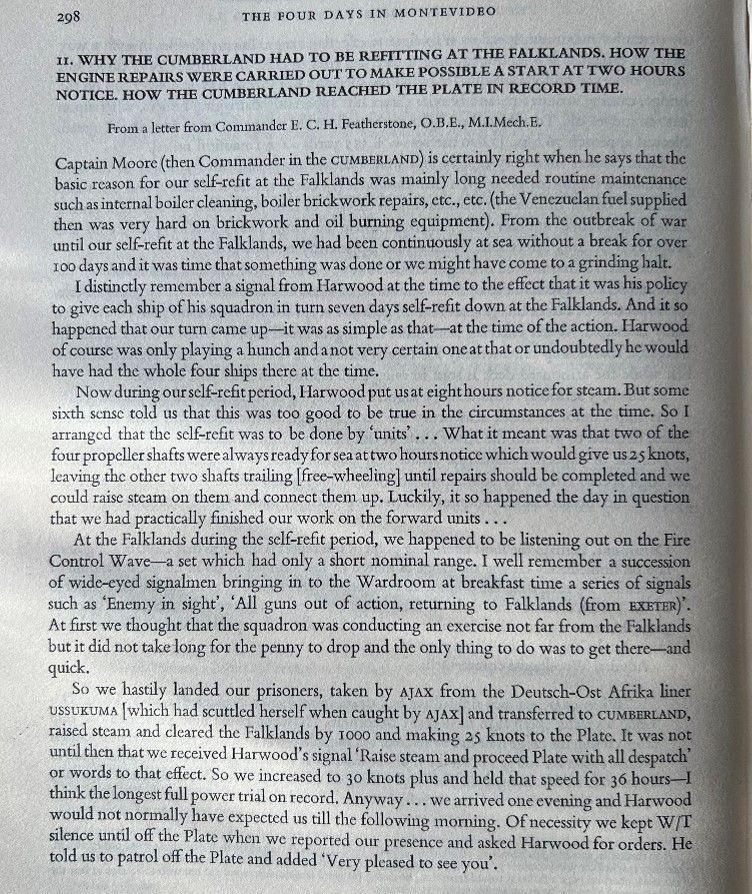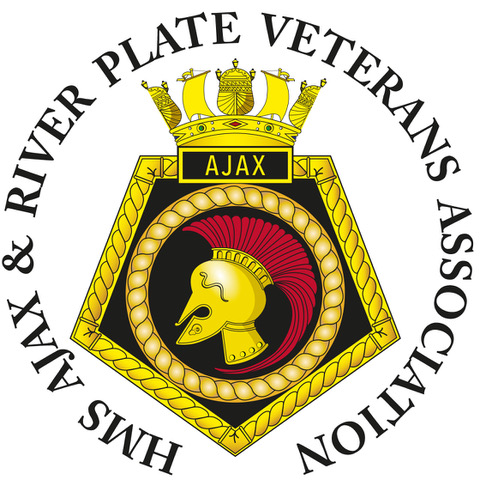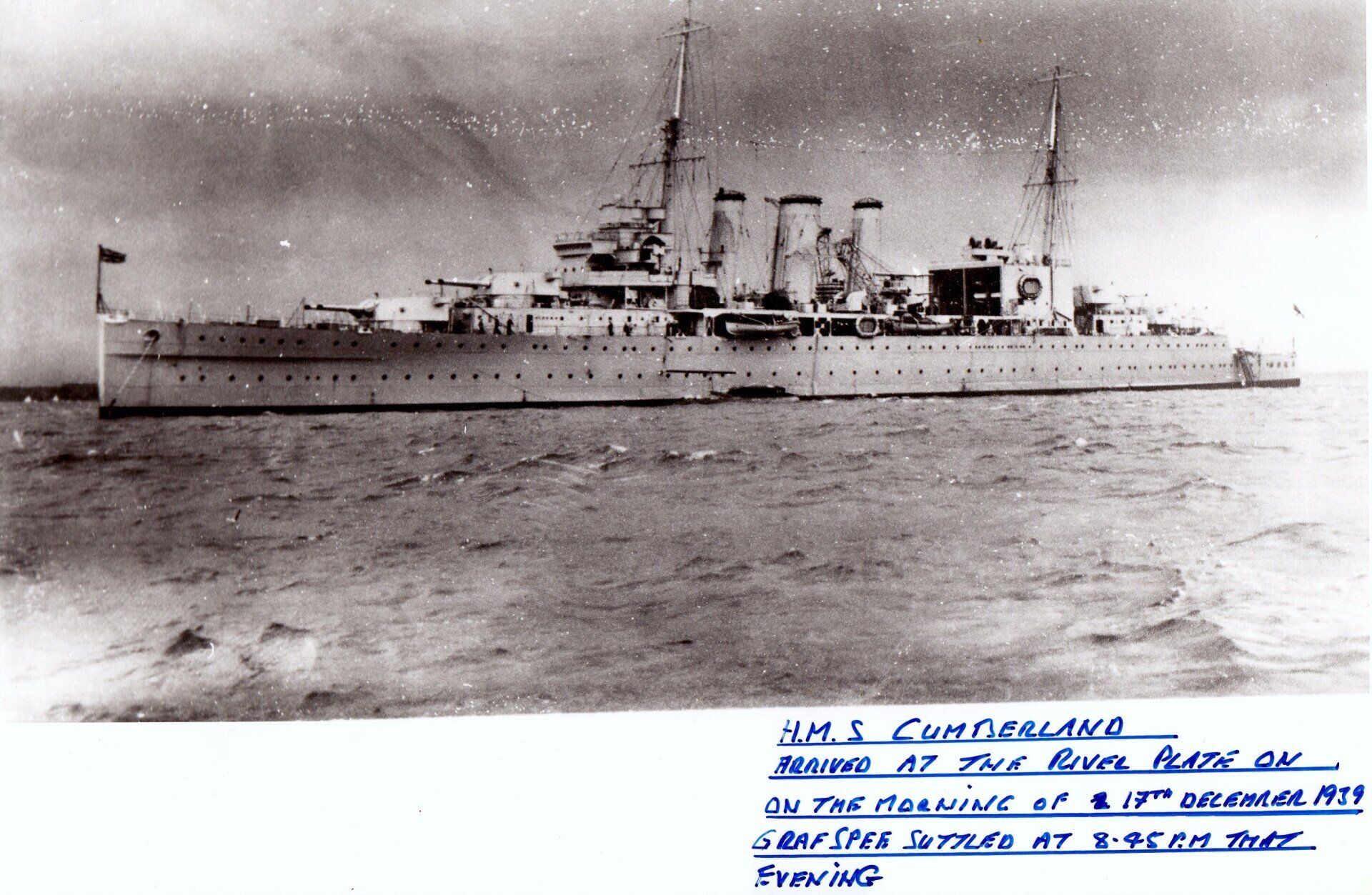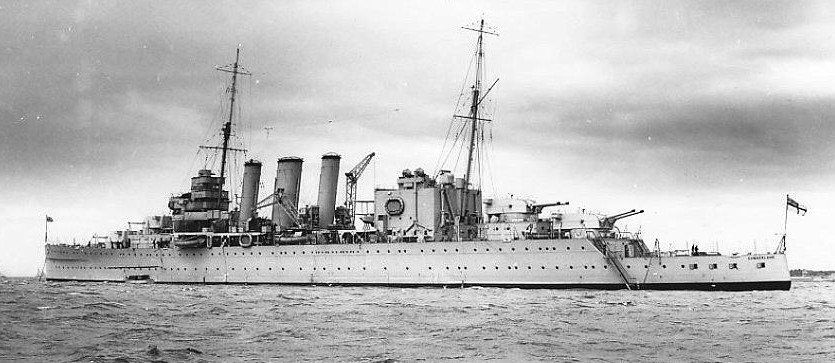HMS Cumberland
HMS Cumberland – By Jonathan Harwood (Grandson of Admiral H Harwood)
The 10th HMS Cumberland was a County class cruiser, built by Vickers Armstrong in Barrow-in-Furness and launched in 1926, HMS Cumberland served on the China Station with the 5th cruiser squadron from 1928 until 1938. She then joined the 2nd cruiser squadron on the South American station. Although built within the Washington Treaty limit of 10,000 tons, her main armament consisted of eight 8” guns. Commander Henry Harwood was Executive Officer (2nd in command) of Cumberland 1927-1929.
At the start of the war in September 1939, Cumberland was assigned to Force G of the South American Division. On her way down to the South Atlantic she was spotted by Admiral Graf Spee’s Arado aircraft on 11th September that was out on reconnaissance searching for British merchant ships. Cumberland did not see the aircraft that was able to return to Graf Spee who happened to be replenishing with Altmark at the time. Using her signal lamp, the aircraft was able to warn of the British cruiser’s close proximity without using her radio. Even though Cumberland was observed to be turning towards Graf Spee, this was considered to be a routine anti-submarine manoeuvre since she then turned back and resumed her course and the two German ships were able to escape.
Another lucky escape occurred on 5th October when Admiral Graf Spee sank the British merchant ship SS Newton Beech, her second victim. Newton Beech managed to put a weak SOS signal that was picked up by another British merchant ship who passed the message by signal lamp to HMS Cumberland as the ships passed each other. Since this was not a RRR raider signal, Captain Fallowfield chose not to interpret this as a surface-raider attack and did not pass this message to Vice Admiral D’Oyly Lyon, the Commander-in-Chief South Atlantic based at Freetown, Sierra Leone. If he had, it is possible that Admiral Graf Spee may have been caught sooner.
At the start of December Cumberland was forced to self-refit in the Falkland Islands, thus depriving Force G of their strongest unit. Nevertheless, Exeter, Ajax and Achilles still engaged Admiral Graf Spee on 13th December at the Battle of the River Plate. During the battle Cumberland received a garbled indication that a contact with the enemy was being made, raised steam and moved north to reinforce, arriving at the River Plate at 22:00 on 14th December, after steaming for 34 hours. Along with Ajax and Achilles (Exeter having been heavily damaged), Cumberland patrolled the estuary, resulting in Graf Spee being scuttled by her crew on 17 December.
After this Cumberland escorted convoys along the African coast, bound for the Middle East and intercepted and sank a Vichy-French merchant ship which had been carrying ammunition. Later that month she attacked Dakar, suffering damage from a French coastal battery.
Cumberland escorted the Arctic convoys during 1941-1944. She was then transferred to the Far East Fleet and carried out raids on Northern Sumatra. After being placed on the reserve list, 1945-49, she was refitted for further service as a gunnery trials ship. She lost her 8-inch turrets and for a few years had prototype turrets fitted. For the 1956 film,’ The Battle of the River Plate, Cumberland played herself, although she was without her 8-inch gun turrets at this time and was refitted with lattice masts, Between 1955 and 1956, HMS Cumberland was fitted with a number of trial anti-A-bomb and anti-H-bomb defences. Her first voyage in this configuration was delayed after some "defects" were found in her engine room, which were not explained as normal mechanical faults. In April 1956, having set sail on another secret test mission, she returned to port within 36 hours following another unexplained "defect" in her main gearbox. Sabotage was suspected.
HMS Cumberland was finally decommissioned in 1958 and was immediately sold for scrapping.
The 11th HMS Cumberland was a Type 22 Frigate. She was launched in 1986 and commissioned in 1989. The frigate was on station during the First Gulf War. Cumberland was decommissioned on 23 June 2011.
Captain Walter Herman Gordon Fallowfield
27 April 1888 – 6 December 1954
Fallowfield was born in Ayrshire. In 1904 he was a midshipman and by December 1931 had attained the rank of captain. In October 1936 he commanded H.M. Naval Establishments at Ceylon and by February 1939 was captain of HMS Cumberland. He was placed on the Retired List on 9 July 1941 but continued to serve in a variety of capacities, including an appointment in command of HM Ships Malaya and Kent in 1944/45.
On 12 April 1946 he reverted to the Retired List as medically unfit, judged mentally ill. Treatments continued to the end of his life but he never regained his faculties despite some improvement in 1948. He died at the age of 66 on 6 December 1954.
The below extract of a letter from Commander E. C. H. Featherstone, O.B.E., M.I.Mech.E from Page 298 The Drama of Graf Spee and the Battle of the River Plate; A Documentary Anthology: 1914-1964” compiled by Sir Eugen Millington-Drake KCMG, British Minister in Montevideo at the time of the Battle (Published 1964) explains why Cumberland was in The Falklands at the time and the journey back up to the River Plate.

HMS Cumberland
Motto: Justitiae tenax
– Tenacious of Justice
Battle Honours
Sadras 1758; Negapatam 1758; Porto Novo 1759; St Vincent 1780; Baltic 1854; Cameroons 1914; North Africa 1942; Arctic 1942-43; Sabang 1944; Burma 1945
Builder: Vickers-Armstrong, Barrow in Furness
Laid down: 18 October 1924
Launched: 16 March 1926
Commissioned: 23 February 1928
Identification; Pennant number 57
Decommissioned: 1946
Recommissioned: 1951
Decommissioned: 1958
Scrapped 3 November 1959
Class and type: County-class heavy cruiser
Displacement:
9,750 tons (9,924 t) standard
13,450 tons (13,670 t) full load
Length: 630ft (190m)
Beam: 68ft 3in (20.80m)
Draught: 16ft 3in (4.95m)
Propulsion:
Eight Admiralty 3-drum boilers
Four shaft Brown Curtis geared turbines
80,000 shp
Speed: 31.5 knots (58.3km/h)
Range:
3,100 nautical miles at 31.5 knots (5,740km at 58km/h),
13,300 nautical miles at 12 knots (24,600km at 22km/h)
Fuel oil 3,400 tons
Complement: 679 (710 as flagship)
Armament: [Original configuration]
8 × 8in (203mm) dual guns
4 × 4in (102mm) single AA guns
2 × 2 pdr (40mm) quadruple pom-pom mounts
2 × 0.5in MG quadruple guns
2 × 21in (533 mm) quad torpedo tubes
Armour: [Original configuration]
1 to 4in magazine box protection
1.375in deck
1in side-plating, turrets and bulkheads
4.5in belt
4 internal boiler room sides (added 1936-1940)
Aircraft carried:
2 Walrus at the time of the River Plate although she was in the Falklands at the time and did not arrive at the River Plate until the next day.


